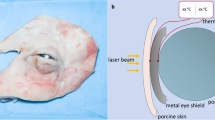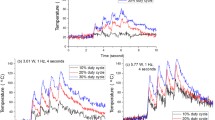Summary
Laser thermokeratoplasty (LTK) can be applied for correction of hyperopia and astigmatism by means of concentrically placed coagulations. Because of the temperature rise during coagulation, damage of the endothelial cells directly below the irradiated areas is possible. In this study, we examined the extent of the thermally denatured zones for different laser parameters and the threshold of thermal endothelial damage as a function of of temperature and duration of elevated temperatures. The threshold for thermal damage of endothelial cells was determined in isotonic NaCl solution for temperature exposures of 10 s and 1 min in a water bath. To determine the damage zones, corneas were irradiated under standardized conditions with a continuously emitting infrared (cw-IR) laser diode at various wavelengths and different power values and were stained after preparation with trypan blue and alizarine red. The extensions of the damage zones were compared with calculated isotherms. Fifty percent cell damage was found at temperatures of 65 °C for heating times of 10 s and at 59 °C for 1 min. With thicker corneas, less laser power and higher absorption coefficients, the damage zone was reduced. The damage range determined corresponded to the calculated isotherms of 60 °C and 70 °C. Regarding clinical LTK, a loss of endothelial cells can be predicted and minimized or totally avoided by choosing the appropriate irradiation parameters.
Zusammenfassung
Hintergrund: Die Laserthermokeratoplastik (LTK) kann durch ringförmig angeordnete Koagulationen in der Peripherie der Hornhaut zur Korrektur der Hyperopie und des hyperopen Astigmatismus angewendet werden. Durch die Temperaturerhöhung während der Koagulation ist eine Schädigung der Endothelzellen direkt unterhalb der bestrahlten Areale möglich. In dieser Arbeit sollten das Ausmaß der Schädigungszonen für verschiedene Laserparameter und die Schädigungsschwellen der Endothelzellen als Funktion der Temperatur und Zeitdauer der Temperaturerhöhung untersucht werden.
Material und Methode: Die Schwelle für einen thermischen Schaden der Endothelzellen wurde in einem temperierten Bad isotonischer NaCl-Lösung bei 10 s und 1 min Expositionsdauer bestimmt. Zur LTK wurden Hornhäute unter standardisierten Bedingungen mit einer kontinuierlich emittierenden Infrarot- (cw-IR) Laserdiode bei verschiedenen Leistungen und Wellenlängen bestrahlt. Die Hornhäute wurden nach Präparation mit Trypanblau und Alizarinrot angefärbt. Die histologisch sichtbaren Schäden wurden dann mit den berechneten Isothermen zur Temperaturerhöhung während der Bestrahlung verglichen.
Ergebnisse: 50 % der Zellen wurden bei Erwärmungszeiten von 10 s bei 65 °C und von 1 min bei 59 °C geschädigt. Nach LTK wurde für dickere Hornhäute, geringere Laserleistungen und höhere Absorptionskoeffizienten der Laserstrahlung das Schadensareal kleiner bis hin zur Schadensvermeidung. Die Zonen für den Endothelschaden lagen im Bereich der berechneten 60 °C- und 70 °C-Isothermen.
Schlußfolgerung: Für die klinisch angewendete LTK läßt sich durch die Wahl geeigneter Bestrahlungsparameter der Endothelzellverlust vorhersagen und somit minimieren oder ganz vermeiden.
Similar content being viewed by others
Author information
Authors and Affiliations
Rights and permissions
About this article
Cite this article
Koop, N., Wirbelauer, C., Tüngler, A. et al. Thermal damage of the corneal endothelium in diode laser thermokeratoplasty. Ophthalmologe 96, 392–397 (1999). https://doi.org/10.1007/s003470050424
Published:
Issue Date:
DOI: https://doi.org/10.1007/s003470050424




